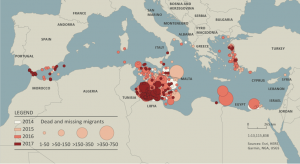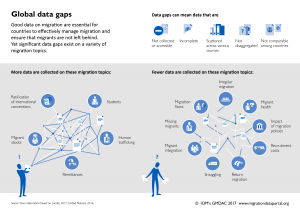More than 27,000 deaths and disappearances during migration worldwide have been recorded since 2014.1
Available data undercount the true number of migrant deaths and data quality and coverage vary significantly from region to region. Gathering more and better quality data on missing migrants is especially important at a time when States are discussing how best to make migration safer. More reliable data could inform policies to reduce the death toll across the globe. According to the 2030 Global Agenda for Sustainable Development, all countries have agreed to work towards promoting safe, orderly and regular migration. This language is also used in the New York Declaration for Refugees and Migration signed in September 2016, which will be followed by the signing of a Global Compact on Migration in 2018. The current draft of this document includes an objective dedicated to saving migrant lives and a commitment to “collect, centralize and systematize data” on migrant bodies. Improving data on deaths occurring during migration is essential to provide a solid evidence base for these policy discussions.
These five recommendations are aimed at improving data on missing migrants, based on IOM’s third Fatal Journeys report.
1. Improve data sharing
The coverage of data on migrant deaths and disappearances is highly fragmented, as information is collected by a wide variety of actors across the world. Data are collected from official sources such as police, border guards, coroners and medical examiners; actors with direct contact with migrants such as humanitarian agencies and survey initiatives; and other unofficial sources such as news reports and social media. Improving data sharing and communication between the many actors working on this issue can aid in tracing and identifying missing migrants as well as the cross-checking and verifying of data.
One notable example of data sharing and communication is IOM’s Missing Migrants Project, which since 2014 collates data on deaths during migration from a wide variety of sources in its database, currently the only publicly-accessible database on migrant deaths worldwide. The Project team is in regular coordination with different data providers in order to share and compare data on migrant deaths worldwide. For example, the Project receives monthly reports from the Pima County Office of the Medical Examiner, which processes most migrant bodies recovered in Arizona. It also coordinates with UNHCR on a weekly basis for data on shipwrecks and bodies recovered in the Mediterranean. In addition to regular communications with many data providers, the Project hosts an anonymized dataset of all deaths recorded on its website since data collection began in 2014.
2. Make better use of administrative data
Few countries collect and publish administrative data disaggregated by migratory status. Administrative sources often provide the most complete data on migrant fatalities – where available. Many migrants die in situations of irregularity, whilst traveling on routes selected to escape detection. This means that their bodies are not found immediately, if at all. When bodies are found, an administrative record of death is made, but often it is more difficult to identify the deceased person.
Data from official sources are far from perfect: administrative data on migrant deaths that do exist are rarely made public or are published only as summary figures, and most regional and national authorities do not distinguish between migrant and non-migrant fatalities. This is echoed by research from the Vrije Universiteit’s Human Costs of Border Control, which showed that consulting administrative records in Southern Europe revealed many migrant deaths not previously recorded in other databases.
3. Promote survey-based data collection
In regions where administrative data are scarce, eyewitness testimonies are often the only evidence of migrant deaths or disappearances. In North Africa and the Horn of Africa, surveys of migrants provide one of the only regular sources of data on migrant fatalities. The surveys conducted by the North Africa Mixed Migration Hub (MHub) in North Africa and Italy, and by the Mixed Migration Monitoring Mechanism (4mi) in Africa and Afghanistan, have documented more than 2,500 migrant deaths based on first-hand accounts. Often, the events reported in the surveys are the only records of these deaths.
Survey-based data are best interpreted as non-representative information that can indicate trends. These data rely on non-representative sampling, are often unverifiable, and are vulnerable to the possibility of double-counting incidents, although, the number of surveys conducted is small compared to the total number of migrants in transit. MHub and 4mi surveyed just under 4,000 total migrants between 2014 and 2017, whereas IOM’s Displacement Tracking Matrix recorded nearly 170,000 migrants transiting through Niger alone in 2017. It is therefore quite likely that existing survey data underestimate the true number of migrant fatalities in regions where other sources of information are scarce.
Questions on migrant deaths in existing surveys should be refined to minimize double-counting and efforts should be made to sample a representative population of migrants where possible. Surveys including questions on migrant deaths should be expanded to other regions where other sources of data are limited, especially in regions like South America, South Asia, and East Asia, where data coverage is extremely poor.
4. Explore new technologies and methodologies
Applying new technologies and methodologies to the collection of data on migrant fatalities has the potential to address the many challenges inherent to collecting any data on irregular migration. In 2017, ‘'big data' from the Automatic Identification System and Broadcast Warnings were used by UN Global Pulse to identify search and rescue patterns in the Mediterranean.2
This approach has the potential to identify best practices when saving migrant lives at sea, if a more systematic analysis of search and rescue operations were conducted. Other sources of big data should also be investigated in the interest of improving our understanding of missing migrants.
Outside of the migration context, new technologies have been piloted to improve the recovery of bodies. For example, drone-based imagery has been used to map remote locations on land for post-mortem examinations (Urbanova et al., 2017), while remotely operated vehicles can be used to recover bodies from shipwrecks, especially in situations involving mass fatalities (Ellingham & Tidball-Binz, 2017). Both of these technologies could help to address the challenges of collecting data in hard-to-access areas.
The proliferation of online media can also be used to improve data on missing migrants. Machine learning can be used to scrape online news and social media posts, an approach currently being piloted by IOM’s Missing Migrants Project. Public social media groups which are frequented by current or would-be migrants can be monitored to find reports of migrant disappearances or deaths. The European Asylum Support Office’s Social Media Monitoring Reports often include such information, though the report aims more generally to collect migration trends and developments. A similar effort targeting data on migrant deaths and disappearances could provide information that is not otherwise available from traditional news media.
5. Work with civil society and families
Any effort to collect data on migrant deaths and disappearances should put the needs of the families first and involve civil society and family groups at all stages of the search and identification process. Many civil society groups collect data on migrants and are often involved in collecting missing persons reports from relatives of migrants. Wherever possible, these groups should be encouraged to collect robust data on migrant deaths and disappearances, as this information can feed into advocacy efforts to prevent further deaths.
Additionally, involving families of missing migrants is crucial throughout the search and identification process. Family members can provide antemortem data needed for the identification of migrant bodies, and can also familiarize researchers with the relevant cultural, religious, or personal beliefs regarding the dead and missing. Even when families cannot provide data, their involvement in search and identification processes can help to meet their right to know what has happened to their loved ones and address the ambiguous loss they face without knowing their fate.
Conclusion
Implementing the recommendations made in this briefing could contribute to improving data on migrant fatalities, and potentially to a better understanding of unsafe migration. Each of these recommendations should be applied at a local, national, and/or regional level according to the data collection challenges specific to each area.
Until there are improvements in the quality and coverage of data on migrant deaths and disappearances, public, academic and policy understanding of deaths and disappearances during migration will remain limited. The collection of reliable data over time is urgently needed so that policymakers can create strong evidence-based policies to save migrant lives and to improve the identification of people who die or go missing.
Disclaimer: The opinions expressed in this blog are those of the authors and do not necessarily reflect the views of the United Nations or the International Organization for Migration (IOM). The designations employed and the presentation of material throughout the blog do not imply the expression of any opinion whatsoever on the part of IOM concerning the legal status of any country, territory, city or area, or of its authorities, or concerning its frontiers and boundaries.
- 1As the Missing Migrants Project is the only current database on migrant deaths worldwide, this blog relies largely on fatalities data from this source.
- 2Hoffmann, K. et. al (2017) Using big data to study rescue patterns in the Mediterranean. Fatal Journeys volume 3: Improving Data on Missing Migrants. Available from http://publications.iom.int/ system/files/pdf/fatal_journeys_volume_3_part_1.pdf









